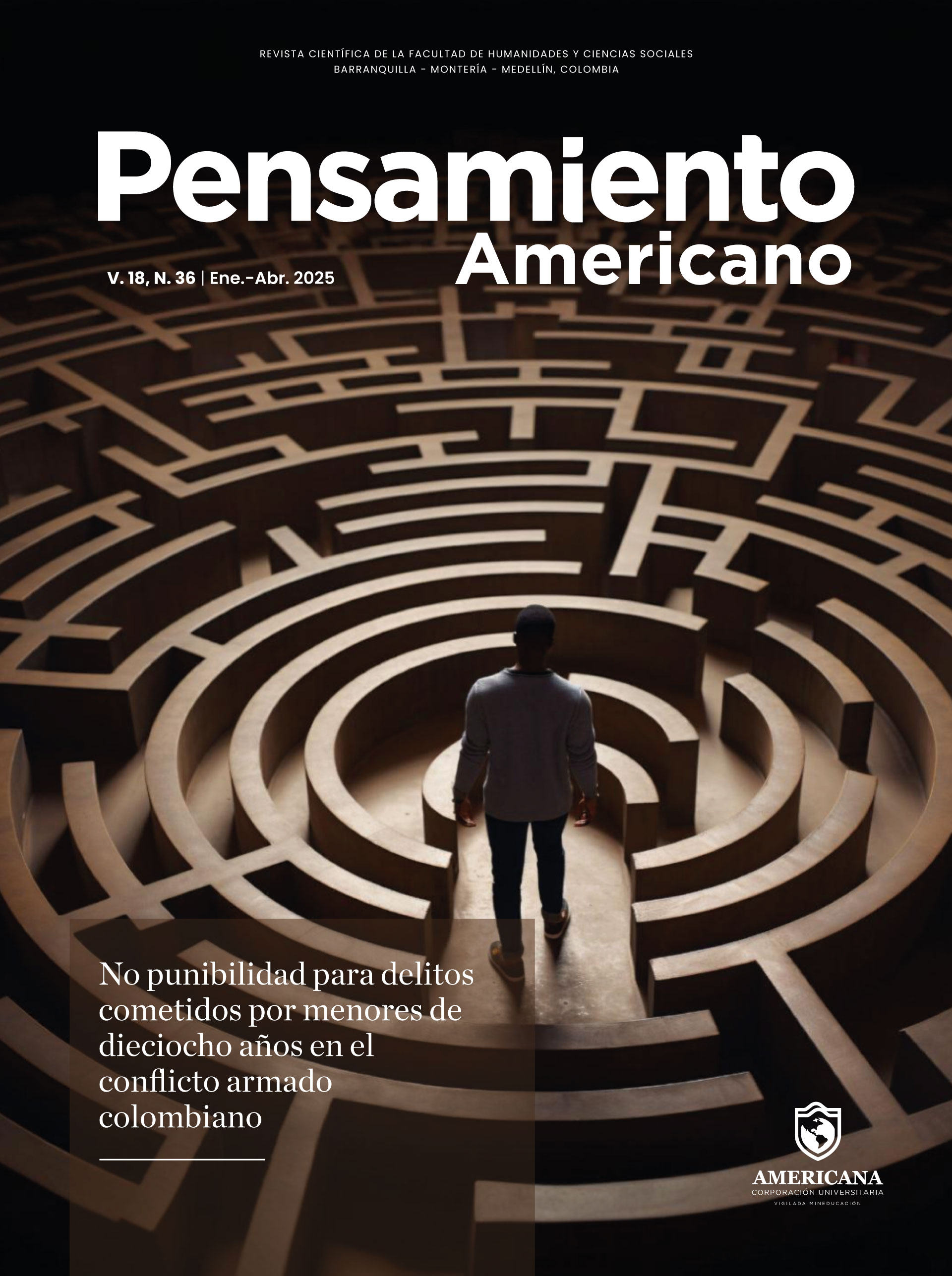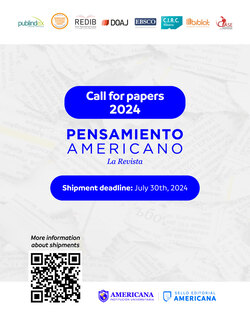Bem-estar subjetivo e qualidade de vida relacionada à saúde em jovens universitarios
DOI:
https://doi.org/10.21803/penamer.18.36.763Palavras-chave:
Emoções, solidão, saúde mental, condição físicaResumo
Introdução: Pesquisas sobre bem-estar subjetivo e qualidade de vida de jovens devem nortear estratégias de promoção da saúde de forma integral. Objetivo: Identificar a relação entre bem-estar subjetivo e qualidade de vida relacionada à saúde em estudantes universitários. Metodologia: A pesquisa foi quantitativa, com delineamento observacional e escopo correlacional. O questionário de perfil PERMA e o questionário de saúde física SF-12 foram utilizados para avaliar as variáveis do estudo. Participaram do estudo 302 estudantes, sendo 72,8% mulheres e 27,2% homens. Resultados: Os estudantes geralmente apresentam bons níveis de bem-estar subjetivo e qualidade de vida, no entanto, observou-se que as emoções negativas e a solidão obtiveram escores moderadamente altos. Em relação à qualidade de vida, observou-se que a vitalidade e a função social são as dimensões que mais afetam a saúde dos universitários. Se há relação entre bem-estar subjetivo e qualidade de vida. Conclusões: Atenção especial deve ser dada ao ambiente emocional, mental e físico dos estudantes universitários, pois estes são os aspectos que mais afetam seu bem-estar e saúde.
Downloads
Referências
Acosta-González, H. N & Marcenario-Gutiérrez, O.D. (2021). The Relationship Between Subjective Well-Being and Self-Reported Health: Evidence from Ecuador. Applied Research Quality Life 16, 1961–1981. https://doi.org/10.1007/s11482-020-09852-z
Alonso, J. (2008). Cuestionario de salud SF-12. http://www.ser.es/wp-content/uploads/2015/03/SF12_CUESTIONARIO.pdf
American Psychological Association. (2002). Código de ética de APA. https://www.apa.org/ethics
Avsec, A., Eisenbeck, N., Carreno, D. F., Kocjan, G. Z., & Kavčič, T. (2022). Coping styles mediate the association between psychological inflexibility and psychological functioning during the COVID-19 pandemic: A crucial role of meaning-centered coping. Journal of Contextual Behavioral Science, 26, 201–209. https://doi.org/10.1016/J.JCBS.2022.10.001
Bosch, M. R., Manent, I. R., & Hernández, J. S. (2022). Ejercicio físico: el tamaño importa. FMC - Formación Médica Continuada En Atención Primaria, 29(10), 529–531. https://doi.org/10.1016/J.FMC.2022.02.008
Butler, J., & Kern, M. (2016). The PERMA-Profiler: A brief multidimensional measure of flourishing. International Journal of Wellbeing, 6(3), 1–48. https://doi.org/10.5502/ijw.v6i3.526Margaret
Cancino, N., González, C., Gallardo, I., & Estrada, C. (2016). Evaluación de un modelo de calidad de vida construido desde los datos. Acta colombiana de Psicología, 19(1), 297-309. https://www.redalyc.org/journal/798/79845405013/html/
Castellanos, R. (2018). El bienestar subjetivo como señal de progreso. Satisfacción con la vida, indicadores objetivos y contexto social. En Millán, R y Castellanos, R. (Ed), Bienestar subjetivo en México. (21-51). Instituto de Investigaciones Sociales.
Cobo-Rendon, R., Aslan Parra, J., & Garcia-Alvarez, D. (2021). Análisis psicométrico del perfil de bienestar “PERMA-PROFILER” en una muestra estudiantes de Psicología. Anuario de Psicología, 35–44. https://doi.org/https://doi.org/10.1344/ANPSIC2021.51/1.5
Cobo-Rendón, R., Pérez Covarrubias, M. V., & Diaz Mujica, A. (2020). Propiedades psicométricas del perma-Profiler para la medición del bienestar en una muestra de estudiantes universitarios chilenos. Revista Ciencias de La Salud, 18(1), 119–133. https://doi.org/10.12804/revistas.urosario.edu.co/revsalud/a.8775
Delgadillo, M. G., Ruiz, F. A., & Aguirre, M. C. (2022). Bienestar subjetivo de estudiantes de Psicología de una universidad pública del noroeste de México. Enseñanza e Investigación en Psicología, 4(2), 611–622.
Dörnyei, Z., Ibrahim. Z., & Muir. C. (2014). Directed Motivational Currents’: regulating complex dynamic systems through motivational surges. In Motivational Dynamics in Language Learning (pp. 95–105). https://doi.org/10.21832/9781783092574-012
Doyle, J. P., Filo, K., Lock, D., Funk, D. C., & McDonald, H. (2016). Exploring PERMA in spectator sport: Applying positive psychology to examine the individual-level benefits of sport consumption. Sport Management Review, 19(5), 506–519. https://doi.org/10.1016/J.SMR.2016.04.007
Dunne, P., & Loughnane, C. (2023). P18 Digital Health Alongside Human Connection: Initial Results: of RCSI’s Coach Connect Platform: Presenter(s): Róisín O’Donovan, RCSI, Ireland. Patient Education and Counseling, 109, 50. https://doi.org/10.1016/J.PEC.2022.10.122
Galdames, S y González, M. (2022). Perfiles de afrontamiento y calidad de vida relacionada con la salud de estudiantes de universidades públicas. Health Education and Health Promotion. 10(3), 625-631. http://hehp.modares.ac.ir/article-5-60868-en.html
García Cruz, R., Cáceres Mesa, M. L., & Bautista Díaz, M. L. (2019). Convivencia y bienestar: categorias necesarias para la educación positiva. Universidad y Sociedad, 11(4), 177–183. https://orcid.org/0000-0003-1154-1737
Goetz, T., Botes, E., Resch, L., Weiss, S., Frenzel, A., & Ebner, M. (2024). Teachers emotionally profit from positive school leadership: Applying the PERMA-Lead model to the control-value theory of emotions . Teaching and Teacher Education. https://doi.org/https://doi.org/10.1016/j.tate.2024.104517
Guevara-Ingelmo, R. M., Guevara-Valtier, M. C., Urchaga-Litago, J. D., Sánchez-Moro, E., & Guevara, R. M. (2022). Practice of physical activity and alcohol consumption in adolescent schoolchildren Autor de Correspondencia. Horizonte Sanitario, 21(2). https://doi.org/https://doi.org/10.19136/hs.a21n2.4838
Guza, E., Gao, L & Lippke, S. (2022). Internet Behavior and Satisfaction with Sleep, Health, Quality of Life and Physical Activity Self-Efficacy as Components of Subjective Well-Being: Findings From an Online Survey. Europe’s Journal of Psychology, 18(4), 357-368. https://doi.org/10.5964/ejop.5343
Hernández-Suárez, C. A., Hernández-Vergel, V., & Prada-Núñez, R. (2018). Adaptación del perfil PERMA de bienestar subjetivo para adultos mayores institucionalizados colombianos. Revista Ciencia y Cuidado, 15(1), 83. https://doi.org/10.22463/17949831.1235
Higuita-Gutiérrez LF, Cardona-Arias JA. (2015). Metaanálisis de la percepción de la calidad de vida relacionada con la salud del adolescente según el género. Revista Facultad Nacional de Salud Pública. 33 (2): 228-238. https://doi.org/10.17533/udea.rfnsp.v33n2a10
Inigo, M., & Raufaste, E. (2019). Academics’ motivations explain time-allocation and well-being at work. European Review of Applied Psychology, 69(1), 19–30. https://doi.org/10.1016/J.ERAP.2018.11.002
Jenkins, L. K., Farrer, R., & Aujla, I. J. (2021). Understanding the impact of an intergenerational arts and health project: a study into the psychological well-being of participants, carers and artists. Public Health, 194, 121–126. https://doi.org/10.1016/J.PUHE.2021.02.029
Jiménez, L., & Jurado, S. (2014). Ansiedad social consumo riesgoso de alcohol en adolescentes mexicanos. Journal of Behavior, Health & Social Issues, 6(1), 37–50. https://doi.org/10.5460/JBHSI.V6.1.47601
Kurnia, A., Kaloeti, D. V. S., Yuniarti, K. W., Siswandi, A. G. P., & Remila, J. M. (2021). Gender and Age Factors in Subjective Wellbeing and Quality of Life Among College Students. Jurnal Psikologi, 20(1), 95-102. https://doi.org/10.14710/jp.20.1.95-102
Li, Z., & Liu, Y. (2023). Theorising language learning experience in LOTE motivation with PERMA: A positive psychology perspective. System, 112, 102975. https://doi.org/10.1016/J.SYSTEM.2022.102975
Lima-Castro, S., Peña-Contreras, E. V., Cedillo-Quizphe, C., & Cabrera-Velez, M. (2017). Adaptación del perfil PERMA en una muestra ecuatoriana. EUREKA, 14(1), 69–83. https://psicoeureka.com.py/sites/default/files/articulos/eureka-14-1-12.pdf
Lovell, T., Mitchell, M., Powell, M., Cummins, B., Tonge, A., Metcalf, E., Ownsworth, T., O’Neill, K., Morris, L., & Ranse, K. (2023). Fostering positive emotions, psychological well-being, and productive relationships in the intensive care unit: A before-and-after study. Australian Critical Care, 36(1), 28–34. https://doi.org/10.1016/J.AUCC.2022.08.001
MacIntyre, P. D., Ross, J., Talbot, K., Mercer, S., Gregersen, T., & Banga, C. A. (2019). Stressors, personality and wellbeing among language teachers. System, 82, 26–38. https://doi.org/10.1016/J.SYSTEM.2019.02.013
Marques da Rosa, V., Daudt, F., Tonetto, L. M., Brust-Renck, P. G., Reed, J. P., & Fogliatto, F. S. (2022). Playful interventions to promote the subjective wellbeing of pediatric cancer inpatients during laboratory and imaging exams: A qualitative study. European Journal of Oncology Nursing, 56, 102094. https://doi.org/10.1016/J.EJON.2022.102094
Martínez, M. P., & Gallardo, I. (2020). Evaluación de la confiabilidad y validez de constructo de la Escala de Calidad de Vida en Salud SF-12 en población chilena (ENCAVI 2015-6). Revista Médica de Chile. http://dx.doi.org/10.4067/S0034-98872020001101568
Organización para la Cooperación y el Desarrollo Económicos OECD (2011), ¿How’s Life?: Measuring Well-being, OECD Publishing, Paris, https://doi.org/10.1787/9789264121164-en.
OECD (2020), How's Life? 2020: Measuring Well-being, OECD Publishing, Paris, https://doi.org/10.1787/9870c393-en.
Reyes-Molina, D., Nazar, G., Cigarroa, I., Zapata-Lamana, R., Aguilar-Farias, N., Parra-Rizo, M, & Albornoz-Guerrero, J. (2022). Comportamiento de la actividad física durante la pandemia por COVID-19 y su asociación con el bienestar subjetivo y salud mental en estudiantes universitarios en Chile. Terapia psicológica, 40(1), 23-26. https://dx.doi.org/10.4067/s0718-48082022000100023
Rojas, M. (2005). “El bienestar subjetivo en México y su relación con indicadores objetivos. Consideraciones para la política pública”. En Calidad de vida y bienestar subjetivo en México, coordinado por León Garduño, Bertha Salinas y Mariano Rojas, 83-111. México: Universidad de las Américas de Puebla/Centro de Estudios sobre Calidad de Vida y Desarrollo Social/International Society of Quality of Life Studies/Plaza y Valdés.
Sánchez-Aragón, A., Valls-Fonayet, F., Pastor-Gosálbez, I., Anleu-Hernández, C. M., & Belzunegui-Eraso, A. (2024). Motivaciones para el consumo de alcohol en adolescentes escolarizados: análisis de grupos de discusión. Atención Primaria, 56(8), 102931. https://doi.org/10.1016/J.APRIM.2024.102931
Schmidt, V., Celsi, I., Molina, M. F., Raimundi, M.-J., García- Arabehety, M., Pérez-Gaido, M., Iglesias, D., & Gonzalez, M. A. (2019). Compromiso con el deporte y su relación con el consumo de alcohol en adolescentes y adultos jóvenes. Cuadernos de Psicología Del Deporte, 19(3), 24–36. https://scielo.isciii.es/pdf/cpd/v19n3/1578-8423-CPD-19-3-00024.pdf
Tavakoly, S.B., Fatemeh, N. A, Hadi Tehrani, E. L y Jafari, A. (2023). Calidad de vida y satisfacción con la vida entre estudiantes universitarios: exploración, normas subjetivas, salud general, optimismo y actitud como mediadores potenciales. Revista de salud del American College, 71(4), 1045-1052, https://doi.org/10.1080/07448481.2021.1920597
The World Health Organization (OMS). (1995). Study protocol for the World Health Organization project to develop a quality of life assessment instrument (WHOQOL). Qual Life Res 2:153-9.
Thomás, J., Nair, D., Juan, P., Beeran, R., Simón, P. (2021) Calidad de vida relacionada con la salud entre los estudiantes de medicina. Revista de la Universidad del Instituto de Ciencias Médicas 16(1), 25-28, https://doi.org/10.4103/jdmimsu.jdmimsu_21_19
Trujillo-Guerrero, T. J., Vázquez-Cruz, E., y Córdova-Soriano, J. A. (2016). Percepción de la funcionalidad familiar y el consumo de alcohol en adolescentes. Atención Familiar, 23(3), 100–103. https://doi.org/10.1016/J.AF.2016.07.003
Urzúa, A, y Caqueo-Urízar, A. (2012). Calidad de vida: Una revisión teórica del concepto. Terapia psicológica, 30(1), 61-71. https://dx.doi.org/10.4067/S0718-48082012000100006
Vera-Villarroel, P., Silva, J., Celis-Atenas, K., y Pavez, P. (2014). Evaluación del cuestionario SF-12: verificación de la utilidad de la escala salud mental. Revista Médica de Chile, 142 (10), 1275-1283. https://dx.doi.org/10.4067/S0034-98872014001000007
Vilagut, G., Valderas, J., Ferrer, M., Garin, O., López, E., & Alonso, J. (2008). Interpretación de los cuestionarios de salud SF-36 y SF-12 en España: componentes físico y mental. Medicina Clínica, 130(19), 726–735. http://public-files.prbb.org/publicacions/e92966f0-cead-012b-a7a8-000c293b26d5.pdf
Xiao, F., Zhang, Z., Zhou, J., Wu, H., Zhang, L., Lin, M., & Hu, L. (2023). The relationship between a growth mindset and the learning engagement of nursing students: A structural equation modeling approach. Nurse Education in Practice, 73, 103796. https://doi.org/10.1016/J.NEPR.2023.103796
Zhang, Z., Chen, B., & Chen, W. (2021). The mediating effect of perceived health on the relationship between physical activity and subjective well-being in Chinese college students. Journal of American college health. 69(1), 9–16. https://doi.org/10.1080/07448481.2019.1645676
Zhang, Z., He, Z & Chen, W. (2020). La relación entre la intensidad de la actividad física y el bienestar subjetivo en estudiantes universitarios. Journal of American College Health, 70(4), 1241-1246, https://doi.org/10.1080/07448481.2020.1790575
Downloads
Publicado
Edição
Seção
Licença
Copyright (c) 2025 Pensamiento Americano

Este trabalho está licenciado sob uma licença Creative Commons Attribution-NonCommercial-NoDerivatives 4.0 International License.
The author or authors of an article accepted for publication in the Journal Pensamiento Americano will transfer all of the patrimonial rights to the American University Corporation free of charge, within which are included: the right to edit, publish, reproduce and distribute both print media as digital, in addition to include in article in international indexes and / or databases, likewise, the Editorial Seal is authorized to use the images, tables and / or any graphic material presented in the article for the design of covers or posters from the same magazine. By assuming the patrimonial rights of the article, it may not be partially or totally reproduced in any printed or digital media without its express permission.
AUTHORITY ASPECTS
For the Pensamiento Americano Journal, all the authors of an article have made substantial contributions to the research and the manuscript, and they share the responsibility when the article presents errors, fraud in some way or violations of copyright.
After submitting an article, the journal does not accept the addition, deletion or change in the order of the authors, in addition we reserve the right to release the article when it has been submitted to the journal and under no circumstances will American Thought accept the article. withdrawal of an article during any phase of the editorial process






